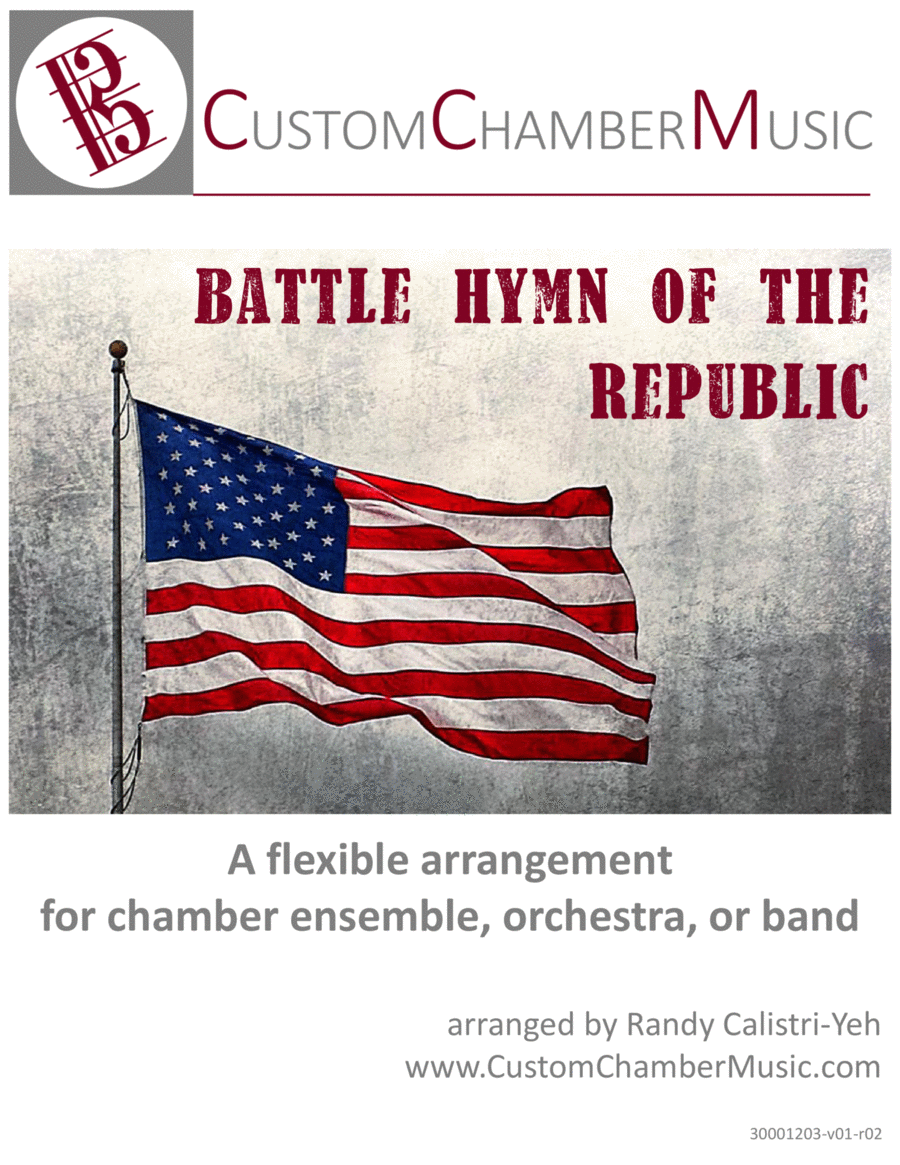Small Ensemble Bass Voice,Bassoon,Cello,Clarinet,Euphonium,Flute,Horn,Oboe,Percussion,Saxophone,Trombone,Trumpet,Viola,Violin - Level 3 - Digital Download SKU: A0.722602 Composed by Traditional. Arranged by Randy Calistri-Yeh. Folk,Holiday,Patriotic,Traditional. Score and parts. 33 pages. Custom Chamber Music #4327099. Published by Custom Chamber Music (A0.722602). Battle Hymn of the Republic, also known as Mine Eyes Have Seen the Glory, is a classic American patriotic tune. This extremely flexible arrangement can be played with anywhere from 3 to 7 parts, suitable for a small chamber group, accompaniment for a choir, or a full band or orchestra (school, community, or professional).This song is also available as part of the collection American Patriotic Music for All, Volume 1, a package of four classic patriotic tunes and three complete Sousa marches (click the publisher link above).To demonstrate the flexibility of this arrangement, the audio clip has an excerpt performed as a full concert band, a string orchestra, and a woodwind trio.This song is in its original key, so it is easy to combine with your own choir or piano/organ parts.Your purchase contains a full score, as well as individual parts in all the appropriate clef and transposition to support the following ensembles:Brass trio, quartet, quintet, and sextet.Woodwind trio, quartet, quintet, and sextet.String trio, quartet, quintet, and sextet.Clarinet trio, quartet, quintet, and sextet.Saxophone trio, quartet, and quintet.Mixed trio, quartet, quintet, and sextet, with optional percussion.Wind ensemble, brass ensemble, string orchestra, full orchestra, and full band.The parts are described as follows:Part 1: Main melody. Piccolo, Flute, Oboe, Bb Clarinet, Soprano Saxophone, Bb Trumpet, Violin, Viola.Part 2: Main harmony, possibly some B-section melody. Bb Clarinet, Alto Clarinet, Alto Saxophone, Bb Trumpet, Violin, Viola.Part 3: Other harmony. Bb Clarinet, Alto/Bass Clarinet, Alto/Tenor Saxophone, French Horn, Bb Trumpet, Trombone, C/Bb Euphonium, Violin, Viola, Cello.Part 4: Main bass line. Bass Clarinet, Baritone Saxophone, Bassoon, Trombone, Bass Trombone, C/Bb Euphonium, Tuba, Cello, Bass.Part 5: Other harmony. Bass Clarinet, Baritone Saxophone, Bassoon, Trombone, Bass Trombone, C/Bb Euphonium, Tuba, Cello, Bass.Part 6: Main melody down an octave, with some additional notes. Bass Clarinet, Bassoon, French Horn, Trombone, C/Bb Euphonium, Cello, Bass.Part 7: Optional percussion (snare drum, bass drum, cymbal) that can be added to any of the above combinations, or skipped entirely.We recommend the following combinations:Trio: Parts 1, 2, 4 (#4 works better than #3 for trio).Quartet: Parts 1, 2, 3, 4.Quintet: Parts 1, 2, 3, 4, 5.Sextet: Parts 1, 2, 3, 4, 5, 6.Septet: Part 1, 2, 3, 4, 5, 6, 7.
